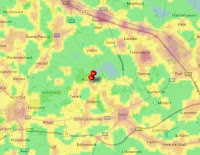Pascal Hilkens Astro Home Page
Sunday, October 30, 2016
DIY Making solar pictures using your DSLR on PST
Sun on oct 30, 2016
Some small active regions on the sun with a couple of bright prominences.
Picture taken using PST Coronado 40 -f/10 and 24mm oculair.
Tuesday, October 25, 2016
300 days to the Eclipse
On August 21, 2017, a total eclipse of the sun will be seen across big parts of the United States of America. See also Great American Eclipse.
Saturday, October 22, 2016
Light Pollution Map
How dark is your sky at night? See latest Light Pollution Map. Thanks to efforts from the city council of #Scherpenheuvel-Zichem we have in my city a much darker sky then the years before.
 |
| Light Pollution Map 2015 |
 |
| Light Pollution Map 2016 |
Friday, October 21, 2016
Mova Globes
 http://movainternational.com/ is the weblink to very original globes which move around with no use of cords, no batteries ... only powered by light and earth magnetic field. Different sizes are available with both space globes as our own earth. I saw those globes the first time in Paris, "maison de l'astronomie" and also in Chicago, Adler Planetarium. I would say ... great gift.
http://movainternational.com/ is the weblink to very original globes which move around with no use of cords, no batteries ... only powered by light and earth magnetic field. Different sizes are available with both space globes as our own earth. I saw those globes the first time in Paris, "maison de l'astronomie" and also in Chicago, Adler Planetarium. I would say ... great gift.Sunday, October 16, 2016
Chromatic Aberration CaF2 material - FCD100 Hoya & FPL53 Ohara
As lenses (like in refractors) have different refractrive properties depending the wavelenghts and the fact that the focal length of a lens is depending the refractiveness results in colors not focussing into a one single point behind the lens. This means that colors will shift in pictures (color glow around moon, planets) which we call chromatic abberation.
Over time refractors became better with double lenses (achromatic lens; the lenses compensate for two wavelengths) and triple lenses (apochromatic lens, lenses compensate for three wavelenghts). For the latter one the flint lens is made of ED glass. This is glass with a very low dispersion properties or high refraction indeces. Typically CaF2 is favorite but expensive, heavy and difficult to manufacture. Therefor the use of other fluorite glasses are used. Currently the use of FPL53(Ohara, JP) and FCD100 (Hoya, JP) are common in small f/ratio refractors and closing the gap with CaF2 glass.
The table below shows that the bigger the F/ratio the lower the chromatic aberration.
Over time refractors became better with double lenses (achromatic lens; the lenses compensate for two wavelengths) and triple lenses (apochromatic lens, lenses compensate for three wavelenghts). For the latter one the flint lens is made of ED glass. This is glass with a very low dispersion properties or high refraction indeces. Typically CaF2 is favorite but expensive, heavy and difficult to manufacture. Therefor the use of other fluorite glasses are used. Currently the use of FPL53(Ohara, JP) and FCD100 (Hoya, JP) are common in small f/ratio refractors and closing the gap with CaF2 glass.
The table below shows that the bigger the F/ratio the lower the chromatic aberration.
Looking into the data, FCD from Hoya has a slightly better refractive indices then FPL53
Subscribe to:
Comments (Atom)








